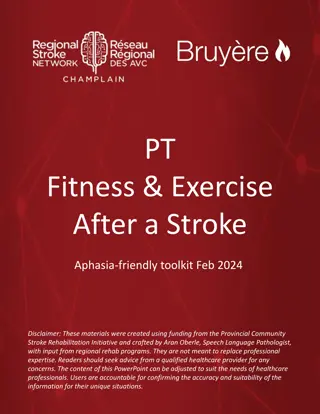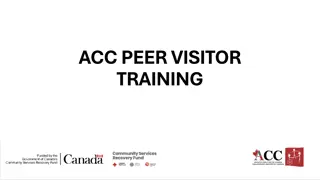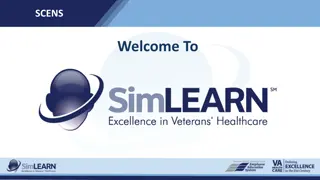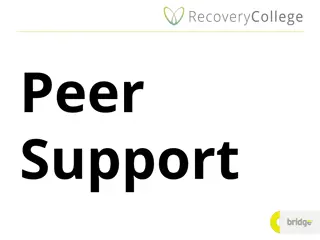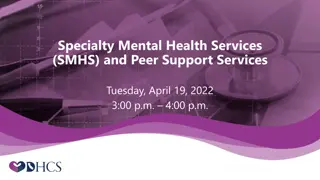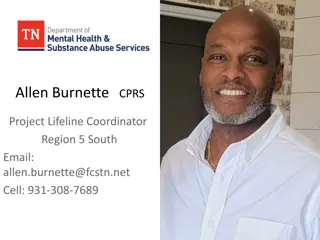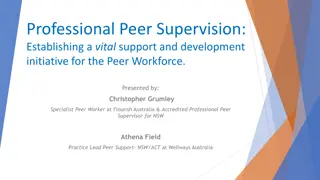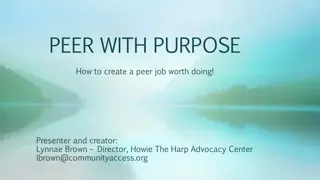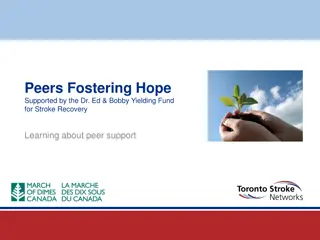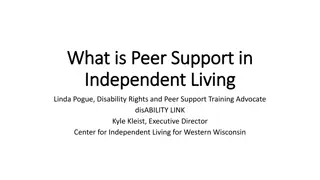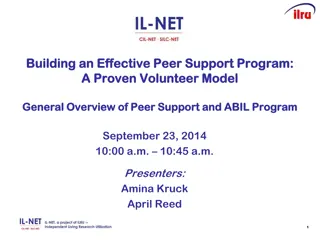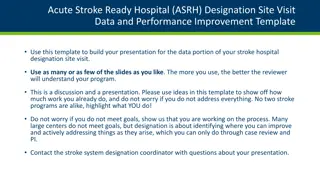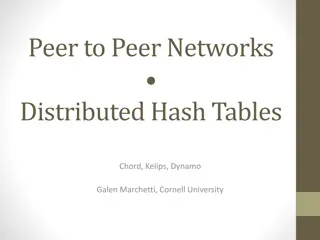Stroke Recovery Peer Support Program Guidelines
Learn about the "Peers Fostering Hope Supported by the Dr. Ed & Bobby Yielding Fund for Stroke Recovery" initiative aiming to re-engage and re-integrate stroke survivors into the community. Explore how peer visitors provide support, encouragement, and hope for community re-engagement and reintegration, following stroke-friendly guidelines for special populations like those with aphasia, paralysis, or visual impairment. Understand the importance of conducting all peer support activities confidentially and respectfully, while also preparing for visits by following specific guidelines and respecting hospital rules.
Download Presentation

Please find below an Image/Link to download the presentation.
The content on the website is provided AS IS for your information and personal use only. It may not be sold, licensed, or shared on other websites without obtaining consent from the author. Download presentation by click this link. If you encounter any issues during the download, it is possible that the publisher has removed the file from their server.
E N D
Presentation Transcript
Peers Fostering Hope Supported by the Dr. Ed & Bobby Yielding Fund for Stroke Recovery Your visit
What do we want to accomplish? The re-engagement and re-integration of stroke survivors into the community.
How will we accomplish this? Peer Visitors (Hospital) Providing Support Encouragement Hope Community Re-engagement/ Reintegration
Stroke Friendly Peer Support Guidelines Special Populations of Stroke Survivors Survivors living with aphasia, paralysis, visual impairment, etc. require heightened level of sensitivity, awareness and skill The following are general/standard stroke friendly Peer Support Guidelines only.
Stroke Friendly Peer Support Guidelines All peer support activities conducted in a confidential and respectful manner Avoid imposing religious, political and medical beliefs & views
Stroke Friendly Peer Support Guidelines Preparing for the visit Visit only when you are well Understand expectations of PFH (ie. visit promptly; provide SRC packages; based on condition of stroke survivor; obtain contact information; report monthly information to the volunteer coordinator)
Stroke Friendly Peer Support Guidelines Respect and observe hospital rules Visiting hours Keep noise level down Wear an ID badge Good hand washing and isolation precautions
Stroke Friendly Peer Support Guidelines Checking in and Checking out Check in with the volunteer department to sign if (if required by the organization) Meet your contact on the unit prior to your visit Track the number of people you ve seen (no names) Check out with main contact on the unit if there are any issues that came up.
Stroke Friendly Peer Support Guidelines Visit structure Greet survivor and/or family member Introduce yourself and let them know why you are there Take time, sit down and visit never sit on the bed or with your back against a window Listen intently and focus on the survivor Try to put a person at ease by commenting first on everyday things Show interest in the survivor by asking about their stroke (if they ask about your experiences keep details brief as this visit is about them) key phrases I remember how frustrating it was . . . I understand how you feel . . .
Stroke Friendly Peer Support Guidelines Visit Structure con t. If survivor asks how long will I be like this? No one can say exactly how long, as every stroke is different; but if you have a positive attitude and work hard, recovery may come more quickly. You may need to learn to do things differently but you may still be able to do those things.
Be aware of the surroundings Privacy Distractions Adaptive aids (glasses, hearing aids)
Be in tuned to the person Their mood (being distracted, pain, fatigued) Medical stability (emotional, cognitive) Other people/staff visiting Their body language Other appointments Other?
Stroke Friendly Peer Support Guidelines Communication :Message(s) from one person to another Ways to communicate Voice Eye contact Facial expression Body language (arms crossed, leaning in) Distance Pacing Remember: Individuals from cultures different than our own may communicate differently.
Stroke Friendly Peer Support Guidelines Listening: a skill that requires patience Stop talking Be attentive Be aware Empathetic Do not interrupt Do not be judgmental Do not give advise Allow anger to be expressed (by the survivor) Allow silence We learn more from listening than from talking
Stroke Friendly Peer Support Guidelines Thoughts of Encouragement There is always hope; never give up keep trying It s not helpful to compare ourselves to others Don t expect too much too soon Exercises that seem very simple help recover function Set realistic SMART goals that you can reach Imagine. . . Hope . . . Believe . . .



